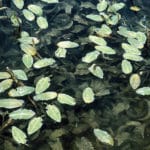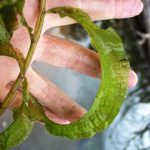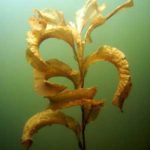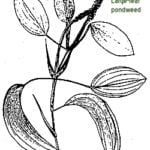Large Leaf Pondweed
Other Common Names:
(Potamogeton amplifolius)
Native
Large leaf pondweed has long, wide floating leaves that curl away from the stem.
Management Options
Click here for more information on how to control large leaf pondweed.
Description
Submersed leaves are folded in the middle and arched, curving away from the stem. These leaves can be one and a half to almost three inches wide and have 25 to 37 veins. Leaf stalks vary in length. Floating leaves are oval, two to four inches long, one to two inches wide, and have many veins. They are on long stalks. Stipules are narrow and come to a sharp point for both submersed and floating leaves. Large leaf pondweed flower stalks (which later fruit) rise above the water and are one to two inches tall. These nutlets are on a thick stem. Large leaf pondweed is often found growing in soft sediments and is easily damaged when boats drive over it. This plant will hybridize with either of two other pondweeds: Illinois or Richardson’s.
Large leaf pondweed is sometimes called musky weed or bass weed because it serves as a prime habitat for those and other types of freshwater fish. Waterfowl feast on the many nutlets this pondweed produces.
Location
Large leaf pondweed can be found across most of the United States except for the southwest.
Propagation
roots, seeds
Management Options
Click here for more information on how to control large leaf pondweed.






